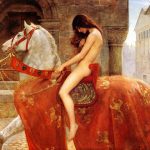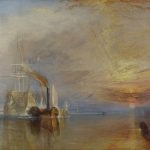
Lady Godiva is an 1898 painting by English artist John Collier, who worked in the style of the Pre-Raphaelite Brotherhood. The portrayal of Lady Godiva and her well-known ride through Coventry, England, is held in Coventry’s Herbert Art Gallery and Museum.
Godiva’s name occurs in charters and the Domesday survey, though the spelling varies. The Old English name Godgifu or Godgyfu meant “gift of God”. Godiva was the Latinised form. Since the name was a popular one, there are contemporaries of the same name.
Legend of Lady Godiva
If she is the same Godiva who appears in the history of Ely Abbey, the Liber Eliensis, written at the end of the 12th century, then she was a widow when Leofric married her.
Both Leofric and Godiva were generous benefactors to religious houses. In 1043 Leofric founded and endowed a Benedictine monastery at Coventry on the site of a nunnery destroyed by the Danes in 1016.
Writing in the 12th century, Roger of Wendover credits Godiva as the persuasive force behind this act. In the 1050s, her name is coupled with that of her husband on a grant of land to the monastery of St. Mary, Worcester and the endowment of the minster at Stow St Mary, Lincolnshire.
She and her husband are commemorated as benefactors of other monasteries at Leominster, Chester, Much Wenlock, and Evesham. She gave Coventry a number of works in precious metal by the famous goldsmith Mannig and bequeathed a necklace valued at 100 marks of silver.
Another necklace went to Evesham, to be hung around the figure of the Virgin accompanying the life-size gold and silver rood she and her husband gave, and St Paul’s Cathedral in the City of London received a gold-fringed chasuble.
She and her husband were among the most munificent of the several large Anglo-Saxon donors of the last decades before the Norman Conquest. The early Norman bishops made short work of their gifts, carrying them off to Normandy or melting them down for bullion.
19th-century equestrian statue of the legendary ride, by John Thomas, Maidstone Museum, Kent.
The manor of Woolhope in Herefordshire, along with four others, was given to the cathedral at Hereford before the Norman Conquest by the benefactresses Wulviva and Godiva – usually held to be this Godiva and her sister. The church there has a 20th-century stained glass window representing them.
Her signature, Ego Godiva Comitissa diu istud desideravi [I, The Countess Godiva, have desired this for a long time], appears on a charter purportedly given by Thorold of Bucknall to the Benedictine monastery of Spalding.
However, this charter is considered spurious by many historians. Even so, it is possible that Thorold, who appears in the Domesday Book as sheriff of Lincolnshire, was her brother. (See Lucy of Bolingbroke.) Source: Wikipedia




